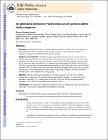| dc.contributor.author | Romero-Ortuno, Roman | en |
| dc.contributor.author | Kenny, Rose | en |
| dc.contributor.author | O'Halloran, Aisling | en |
| dc.contributor.author | Knight, Silvin | en |
| dc.date.accessioned | 2024-01-12T10:55:53Z | |
| dc.date.available | 2024-01-12T10:55:53Z | |
| dc.date.issued | 2024 | en |
| dc.date.submitted | 2024 | en |
| dc.identifier.citation | Feng Xue, Silvin P. Knight, Emma Connolly, Aisling M. O�Halloran, Morgana Afonso Shirsath, Louise Newman, Eoin Duggan, Rose Anne Kenny, Roman Romero-Ortuno, Were Frailty Identification Criteria Created Equal? A Comparative Case Study on Continuous Non-Invasively Collected Neurocardiovascular Signals during an Active Standing Test in the Irish Longitudinal Study on Ageing (TILDA), Sensors, 2024 | en |
| dc.identifier.other | Y | en |
| dc.identifier.uri | http://hdl.handle.net/2262/104366 | |
| dc.description | IN_PRESS | en |
| dc.description.abstract | Background: In this observational study, we compared continuous physiological signals
during an active standing test in adults aged 50 years and over, characterised as frail by three different
criteria, using data from The Irish Longitudinal Study on Ageing (TILDA). Methods: This study
utilised data from TILDA, an ongoing landmark prospective cohort study of community-dwelling
adults aged 50 years or older in Ireland. The initial sampling strategy in TILDA was based on random
geodirectory sampling. Four independent groups were identified: those characterised as frail only
by one of the frailty tools used (the physical Frailty Phenotype (FP), the 32-item Frailty Index (FI),
or the Clinical Frailty Scale (CFS) classification tree), and a fourth group where participants were
not characterised as frail by any of these tools. Continuous non-invasive physiological signals were
collected during an active standing test, including systolic (sBP) and diastolic (dBP) blood pressure,
as well as heart rate (HR), using digital artery photoplethysmography. Additionally, the frontal
lobe cerebral oxygenation (Oxy), deoxygenation (Deoxy), and tissue saturation index (TSI) were also
non-invasively measured using near-infrared spectroscopy (NIRS). The signals were visualised across
frailty groups and statistically compared using one-dimensional statistical parametric mapping (SPM).
Results: A total of 1124 participants (mean age of 63.5 years; 50.2% women) were included: 23 were
characterised as frail only by the FP, 97 by the FI, 38 by the CFS, and 966 by none of these criteria.
The SPM analyses revealed that only the group characterised as frail by the FI had significantly
different signals (p < 0.001) compared to the non-frail group. Specifically, they exhibited an attenuated
gain in HR between 10 and 15 s post-stand and larger deficits in sBP and dBP between 15 and 20 s
post-stand. Conclusions: The FI proved to be more adept at capturing distinct physiological responses
to standing, likely due to its direct inclusion of cardiovascular morbidities in its definition. Significant
differences were observed in the dynamics of cardiovascular signals among the frail populations
identified by different frailty criteria, suggesting that caution should be taken when employing frailty
identification tools on physiological signals, particularly the neurocardiovascular signals in an active
standing test. | en |
| dc.language.iso | en | en |
| dc.relation.ispartofseries | Sensors | en |
| dc.rights | Y | en |
| dc.subject | Frailty comparison | en |
| dc.subject | Statistical parametric mapping | en |
| dc.subject | Cardiovascular | en |
| dc.subject | Neurovascular | en |
| dc.subject | Frailty index | en |
| dc.subject | Continuous physiological monitoring | en |
| dc.subject | Frailty phenotype | en |
| dc.subject | Clinical frailty scale | en |
| dc.subject | Active stand | en |
| dc.title | Were Frailty Identification Criteria Created Equal? A Comparative Case Study on Continuous Non-Invasively Collected Neurocardiovascular Signals during an Active Standing Test in the Irish Longitudinal Study on Ageing (TILDA) | en |
| dc.type | Journal Article | en |
| dc.type.supercollection | scholarly_publications | en |
| dc.type.supercollection | refereed_publications | en |
| dc.identifier.peoplefinderurl | http://people.tcd.ie/romeroor | en |
| dc.identifier.peoplefinderurl | http://people.tcd.ie/siknight | en |
| dc.identifier.peoplefinderurl | http://people.tcd.ie/aiohallo | en |
| dc.identifier.peoplefinderurl | http://people.tcd.ie/rkenny | en |
| dc.identifier.rssinternalid | 261151 | en |
| dc.identifier.doi | https://doi.org/10.3390/s24020442 | en |
| dc.rights.ecaccessrights | openAccess | |
| dc.subject.TCDTheme | Ageing | en |
| dc.subject.TCDTheme | Digital Engagement | en |
| dc.subject.TCDTag | Frailty & Resilience | en |
| dc.subject.TCDTag | PHYSIOLOGY | en |
| dc.identifier.rssuri | https://www.mdpi.com/1424-8220/24/2/442 | en |
| dc.identifier.orcid_id | 0000-0002-3882-7447 | en |
| dc.subject.darat_impairment | Age-related disability | en |
| dc.subject.darat_impairment | Chronic Health Condition | en |
| dc.subject.darat_impairment | Mobility impairment | en |
| dc.subject.darat_thematic | Health | en |
| dc.subject.darat_thematic | Third age/ageing | en |
| dc.status.accessible | N | en |
| dc.contributor.sponsor | Science Foundation Ireland (SFI) | en |
| dc.contributor.sponsorGrantNumber | 18/FRL/6188 | en |







